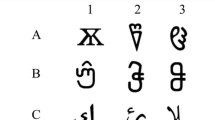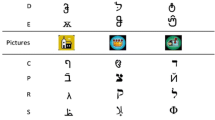Abstract
AB, BC, CD, and DE were established by conditional discrimination training. Symmetry, transitivity, and equivalence tests were then passed demonstrating the formation of 5-member equivalence classes. These tests were passed even though they were conducted in the absence of baseline relations. A new stimulus (F) was then linked to a class member (A) by stimulus fading conducted in the context of simple discrimination training. Thereafter, subjects passed FB, FC, FD, FE, BF, CF, DF, and EF tests, demonstrating that F functioned as a new member of the A-E class. The expansion of equivalence classes can also be accomplished by the use of simple discrimination training combined with stimulus fading, in addition to the typical use of conditional discrimination training. Equivalence classes, then, can be defined independently of conditional discrimination procedures.
Similar content being viewed by others
References
DEVANY, J. M., HAYES, S. C., & NELSON, R. O. (1986). Equivalence class formation in language-able and language disabled children. The Journal of the Experimental Analysis of Behavior, 46, 243–257.
ETZEL, B. C., & LEBLANC, J. M. (1979). The simplest treatment alternative: The law of parsimony applied to choosing appropriate instructional control and errorless-learning procedures for the difficult-to-teach child. Kansas Research Institute for the Early Childhood Education of the Handicapped (Eci Document No. 131). Lawrence Ks.
FIELDS, L. (1978). Fading and errorless transfer in successive discriminations. The Journal of the Experimental Analysis of Behavior. 30, 123–128.
FIELDS, L. (1979). Acquisition of stimulus control while introducing new stimuli in fading. The Journal of the Experimental Analysis of Behavior, 32, 121–127.
FIELDS, L. (1981). Early and late introduction of probes and stimulus control acquisition in fading. The Journal of the Experimental Analysis of Behavior, 36, 363–370.
FIELDS, L. (1985). Reinforcement of probe responses and acquisition of stimulus control in fading procedures. The Journal of the Experimental Analysis of Behavior, 43, 235–241.
FIELDS, L. (1989). Equivalence class formation; a paradigm for the analysis of complex human behavior. A keynote address presented at the Experimental Analysis of Behavior Easter Conference, Cambridge University, England, April 11-13.
FIELDS, L., ADAMS, B. J., VERHAVE, T., & NEWMAN, S. (1990). The effects of nodality on the formation of equivalence classes. The Journal of the Experimental Analysis of Behavior, 53, 345–358.
FIELDS, L., BRUNO, V., & KELLER, K. (1976). The stages of acquisition in stimulus fading. The Journal of the Experimental Analysis of Behavior, 26, 295–300.
FIELDS, L., REEVE, K., ADAMS, B. J., & VERHAVE, T. (1991). Stimulus generalization and equivalence classes: A model for natural categories. The Journal of the Experimental Analysis of Behavior, 55, 23–30.
FIELDS, L., & VERHAVE, T. (1987). The structure of equivalence classes. The Journal of the Experimental Analysis of Behavior, 49, 317–332.
KAMIN, L. J. (1968). “Attention-like” processes in classical conditioning. In M. R. Jones (Ed.), Miami symposium on the prediction of behavior: Aversive stimulation (pp. 9–31). Miami, Fl: University of Miami.
KARPICKE, J., & HEARST, E. (1975). Inhibitory control and errorless discrimination learning. The Journal of the Experimental Analysis of Behavior, 23, 158–166.
MCILVANE, W. J., BASS, R. W., O’BRIEN, J. M., GEROVAC, B. J., & STODDARD, L. T. (1984). Spoken and signed naming of foods after receptive exclusion training in severe retardation. Applied Research in Mental Retardation, 5, 1–27.
RAY, B. A., & SIDMAN, M. (1970). Reinforcement schedules and stimulus control. In W. N. Schoenfeld & J. Farmer (Eds.), Theory of reinforcement schedules (pp. 187–218). New York, NY: Appleton-Century-Crofts.
SAUNDERS, R. R., SAUNDERS, K. J., KIRBY, K. C., & SPRADLIN, J. E. (1988). The merger and development of equivalence classes by unreinforced conditional selection of comparison stimuli. The Journal of the Experimental Analysis of Behavior, 50, 145–162.
SAUNDERS, R. R., WACHTER, J. A., & SPRADLIN, J. E. (1988). Establishing auditory stimulus control over an eight-member stimulus class via conditional discrimination procedures. The Journal of the Experimental Analysis of Behavior, 49, 95–115.
SCHILMOELLER, G. L., SCHILMOELLER, K. J., ETZEL, B. C., & LEBLANC, J. M. (1979). Conditional discrimination after errorless and trial-and error training. The Journal of the Experimental Analysis of Behavior. 31, 405–420.
SCHREIBMAN, L. (1975). Effects of within-stimulus and extra-stimulus prompting on discrimination learning with autistic children. Journal of Applied Behavior Analysis, 8, 91–112.
SIDMAN, M. (1971). Reading and auditory-visual equivalences. Journal of Speech and Hearing Research, 14, 5–13.
SIDMAN, M. (1990) Equivalence relations: Where do they come from? In H. Lejuene & D. Blackman (Eds.), Behavior analysis in theory and practice: Contributions and controversies (pp. 93–114). Hillsdale, NJ: Erlbaum.
SIDMAN, M., KIRK, B., & WILLSON-MORRIS, M. (1985). Six-member stimulus classes generated by conditional-discrimination procedures. The Journal of the Experimental Analysis of Behavior, 37, 5–22. (43, 21-42).
SIDMAN, M., & STODDARD, L. T., (1967). The effectiveness of fading in programing simultaneous form discrimination for retarded children. The Journal of the Experimental Analysis of Behavior, 10, 3–15.
SIDMAN, M., WYNNE, C. K., MAGUIRE, R. W., & BARNES, T. (1989). Functional classes and equivalence relations. The Journal of the Experimental Analysis of Behavior, 52, 261–274.
SINGH, N. N., & SOLMAN, R. (1991). A stimulus control analysis of the picture- word problem in children who are mentally retarded: The blocking effect. Journal of Applied Behavior Analysis, 23, 525–532.
SPRADLIN, J. E., & SAUNDERS, R. R. (1986). The development of stimulus classes using match-to-sample procedures: Sample classification versus comparison classification. Analysis and Intervention in Developmental Disabilities, 6, 41–58.
SUTHERLAND, N. S., & MACKINTOSH, N. J. (1971). Mechanisms of discrimination learning. New York: Academic Press.
TERRACE, H. S. (1963). Errorless transfer of a discrimination across two continua. The Journal of the Experimental Analysis of Behavior, 6, 223–232.
TOUCHETTE, P. E. (1971). Transfer of stimulus control: Measuring the moment of transfer. The Journal of the Experimental Analysis of Behavior, 15, 347–354.
VOM SAAL, W., & JENKINS, H. M. (1970). Blocking the development of stimulus control. Learning and Motivation, 1, 52–64.
Author information
Authors and Affiliations
Additional information
This research was supported partly by NICHHD Grant RO1-HD21110, PSC/CUNY Grants 666199 and 668457, and United States Army Research Institute Contract MDA903-90-C-0132. Partial support was also provided by an OMRDD Fellowship in the CSI/IBR Center for Developmental Neurosciences to Sandra Newman.
Rights and permissions
About this article
Cite this article
Fields, L., Newman, S., Adams, B.J. et al. The Expansion of Equivalence Classes Through Simple Discrimination Training and Fading. Psychol Rec 42, 3–15 (1992). https://doi.org/10.1007/BF03399583
Published:
Issue Date:
DOI: https://doi.org/10.1007/BF03399583




